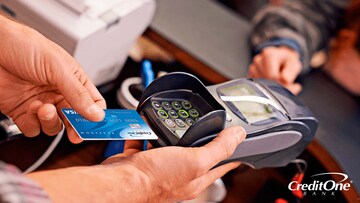March 16, 2021
Topics:
Credit CardIf you find the magnetic stripe on your credit card is no longer working, it may have become demagnetized. Check out these tips on keeping this from happening.

The magnetic stripe of your credit card contains a lot of sensitive data necessary to conduct a credit card transaction, such as the account number, the cardholder’s name, the card expiration date, a service code, and even a card verification code, also known as a CVV (card verification value). Because information is stored magnetically via iron-oxide particles on that stripe, it can be susceptible to becoming demagnetized by magnetic fields given off by other magnet or electronics. Should your credit or debit card’s magnetic stripe come in direct contact with—or in close proximity to—a strong enough magnetic field, those particles could become smeared or rearranged, rendering it useless.
EMV Chips Are Resistant to Magnets
The good news is that all credit cards issued in the United States today are equipped with EMV chips, which are more secure than magnetic stripes and contain important information required to process credit card transactions. These chips, which house tiny microprocessors, are not affected by magnets.
Most of the “card present” purchases you make with your credit card these days are likely made via EMV chip at a chip-reading terminal. However, there are still merchants out there not yet equipped with these more modern terminals, and they may still rely on swiping credit and debit card magnetic stripes. You could also find yourself in a situation where the chip in your card isn’t functioning properly or there’s an issue with the chip reader of a terminal. In these cases, the card’s magnetic stripe serves as a backup method to process transactions. So, even in the age of EMV chips, it’s still important to have a functioning magnetic stripe on your credit card.
Ways to Avoid Demagnetizing Your Credit Card
The most obvious way to avoid demagnetizing the magnetic stripe of your credit card is to avoid exposing your card to magnetic fields. And the key to doing this is understanding when and where exposure to a magnetic field could occur. Here are a few common-sense tips:
- Do Not Touch or Rub the Magnetic Stripe with a Magnet: This seems fairly obvious, but it still warrants mentioning. Do not purposely place another magnet on or near your credit card’s magnetic stripe. Don’t do it as a dare, don’t do it as a science experiment, don’t do it out of boredom. Just don’t do it. If you’re purposely trying to demagnetize the magnetic stripe, chances are you’ll succeed.
- Do Not Carry Your Card in Anything with a Magnetic Clasp: If your money clip, wallet, or purse uses a magnetic clasp to hold it closed, there’s a possibility it could demagnetize the magnetic stripe on your credit card—especially over time. It may be unlikely, but it could still happen, which is why some manufacturers of these items recommend using their magnetized products to carry cash, not credit cards.
- Do Not Store or Carry Two Cards with Their Magnetic Stripes Touching: Carry your credit and debit cards in separate slots of your wallet or purse. If you place two cards in the same slot, and their magnetic stripes are pressed together, that’s magnet-on-magnet action, and it could wind up demagnetizing one or both of the cards.
- Keep Your Card Away from Security Sensor Removal Devices: If you’re purchasing something from a store that has a theft-deterring security sensor attached to it, be careful not to get your credit or debit card too close to the device use to remove it at the cash register. These devices are typically magnetic and could distort or erase the information on your card’s magnetic stripe.
- Don’t Carry Your Card with Your Smartphone: Carrying your card in the same case as your smartphone, or laying your card on your smartphone could damage the card’s magnetic stripe over time. This includes other electronic devices that create magnetic fields as well, such as laptops or tablets.
- Keep Your Card Away from MRI Machines: You’re not allowed to have a credit card in an MRI machine, but even just being near one of these magnetic resonance imaging machines, which generate powerful magnetic fields, could damage your credit card’s magnetic stripe.
Avoid Other Potential Damage as Well
Demagnetization is not the only way to damage a credit card’s magnetic stripe. It can also fail to work properly if it’s dirty. So, keep your card’s stripe clean by occasionally wiping it with a clean, soft cloth—or use adhesive tape to remove dirt, dust, or other debris.
A magnetic stripe can also be scratched, nicked up or worn off of credit card to the point it’s no longer readable by a terminal. To avoid damaging the stripe in this way, don’t carry your credit card in a pocket full of loose change or other items that could rub against the stripe and wear it off. Whenever possible, protect it by carrying it in a plastic case or a wallet or purse—just not one with a magnetic clasp!
What to Do if Your Card’s Magnetic Stripe is Damaged
Firstly, don’t panic. Remember, reading the EMV chip in your card is still the preferred method of conducting credit or debit card transactions at the majority of merchants out there. But you don’t want to wait until you actually need to use a damaged magnetic stripe to replace it. So, as soon as you realize the stripe has been damaged, contact your credit card issuer for a replacement card. Then, once you’ve received your new card, activate it and dispose of your old card properly.
After realizing he couldn’t pay back his outrageous film school student loans with rejection notices from Hollywood studios, Sean focused his screenwriting skills on scripting corporate videos. Videos led to marketing communications, which led to articles and, before he knew it, Sean was making a living as a writer. He continues to do so today by leveraging his expertise in credit, financial planning, wealth-building, and living your best life for Credit One Bank.



